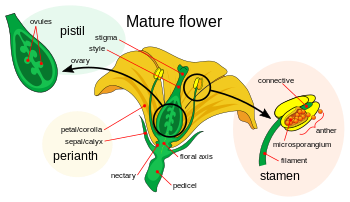
In botany, floral morphology is the study of the diversity of forms and structures presented by the flower, which, by definition, is a branch of limited growth that bears the modified leaves responsible for reproduction and protection of the gametes, called floral pieces.[note 1]
Fertile leaves or sporophylls carry sporangiums, which will produce male and female gametes and therefore are responsible for producing the next generation of plants. The sterile leaves are modified leaves whose function is to protect the fertile parts or to attract pollinators.[1] The branch of the flower that joins the floral parts to the stem is a shaft called the pedicel, which normally dilates at the top to form the receptacle in which the various floral parts are inserted.
All spermatophytes ("seed plants") possess flowers as defined here (in a broad sense), but the internal organization of the flower is very different in the two main groups of spermatophytes: living gymnosperms and angiosperms. Gymnosperms may possess flowers that are gathered in strobili, or the flower itself may be a strobilus of fertile leaves. Instead, a typical angiosperm flower possesses verticils or ordered whorls that, from the outside in, are composed first of sterile parts, commonly called sepals (if their main function is protective) and petals (if their main function is to attract pollinators), and then the fertile parts, with reproductive function, which are composed of verticils or whorls of stamens (which carry the male gametes) and finally carpels (which enclose the female gametes).[2]
The arrangement of the floral parts on the axis, the presence or absence of one or more floral parts, the size, the pigmentation and the relative arrangement of the floral parts are responsible for the existence of a great variety of flower types. Such diversity is particularly important in phylogenetic and taxonomic studies of angiosperms. The evolutionary interpretation of the different flower types takes into account aspects of the adaptation of floral structure, particularly those related to pollination, fruit and seed dispersal and of protection against predators of reproductive structures.[3][4][5]
Cite error: There are <ref group=note> tags on this page, but the references will not show without a {{reflist|group=note}} template (see the help page).
- ^ Diccionario de Botánica (in Spanish) (8th ed.). Barcelona, Spain: Editorial Labor, S. A. 1982.
- ^ "Flower Morphology of Plants". 2009-05-16. Archived from the original on 2009-05-16. Retrieved 2022-09-22.
- ^ Barnard, G. (1961). The interpretation of the angiosperm flower. Aust. J. Sci. 24: 64-72.
- ^ Carlquist, S. (1969). "Towards acceptable evolutionary interpretations of floral anatomy." Phytomorphology 19:332-362.
- ^ Foster, A. S. & Gifford, E. M. (1974). Comparative morphology of seed plants. San Francisco, Freeman & Co.
© MMXXIII Rich X Search. We shall prevail. All rights reserved. Rich X Search
